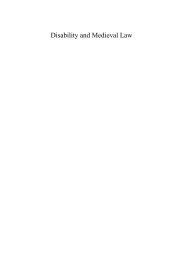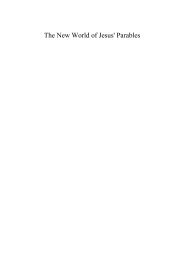Sample pdf - Cambridge Scholars Publishing
Sample pdf - Cambridge Scholars Publishing
Sample pdf - Cambridge Scholars Publishing
You also want an ePaper? Increase the reach of your titles
YUMPU automatically turns print PDFs into web optimized ePapers that Google loves.
10<br />
Chapter One<br />
1.1.3 FrameNet<br />
FrameNet is a computational lexicographic project whose purpose is to<br />
represent information about the semantic and syntactic properties of<br />
English words and encode this information in a database (FrameNet,<br />
2008). This information is extracted from large electronic corpora using<br />
manual and electronic techniques. Although FrameNet was not developed<br />
for terms, the database and its construction technique may be very useful<br />
in describing them (van der Vliet, 2006). FrameNet is based on the theory<br />
of Frame Semantics, whose central idea is that word meanings must be<br />
described in relation to semantic frames.<br />
The linguistic basis of FrameNet is Fillmore's theory of Case Grammar<br />
(Fillmore, 1968). FrameNet itself was developed in two stages: FrameNet<br />
I and FrameNet II (FrameNet, 2008). The FrameNet database consists of a<br />
lexical database and an annotation database. The lexical database contains<br />
entities of the following types:<br />
• frames: named data structures which are used to represent a<br />
concept in a domain, e.g. survey;<br />
• frame elements (FEs): kinds of entities that can participate in the<br />
frame, e.g. FEs of the frame survey are: contractor, object,<br />
purpose;<br />
• lexemes: sets of forms taken by a single word (e.g. the English verb<br />
lexeme measure has four word forms: measure, measures,<br />
measured, measuring);<br />
• lemmas: particular forms of the lexeme that are chosen by<br />
convention, e.g. measure is the lemma of the verb lexeme measure.<br />
The lemma is the canonical form of a lexeme and in lexicography it<br />
is usually also the citation form or headword by which it is<br />
indexed;<br />
• lexical units (LUs): associations between lemmas (units of form)<br />
and frames (units of meaning). LUs correspond to dictionary<br />
senses.<br />
The following types of relations between frames and frame elements<br />
exist in FrameNet:<br />
1. Frame Inheritance. Frame Inheritance is a relation between frames<br />
which depends on the fact that a more specific frame inherits from<br />
a more general frame, e.g. the Surveying_tools frame evoked by the<br />
verbs measure, set out and level inherits from the more general
















